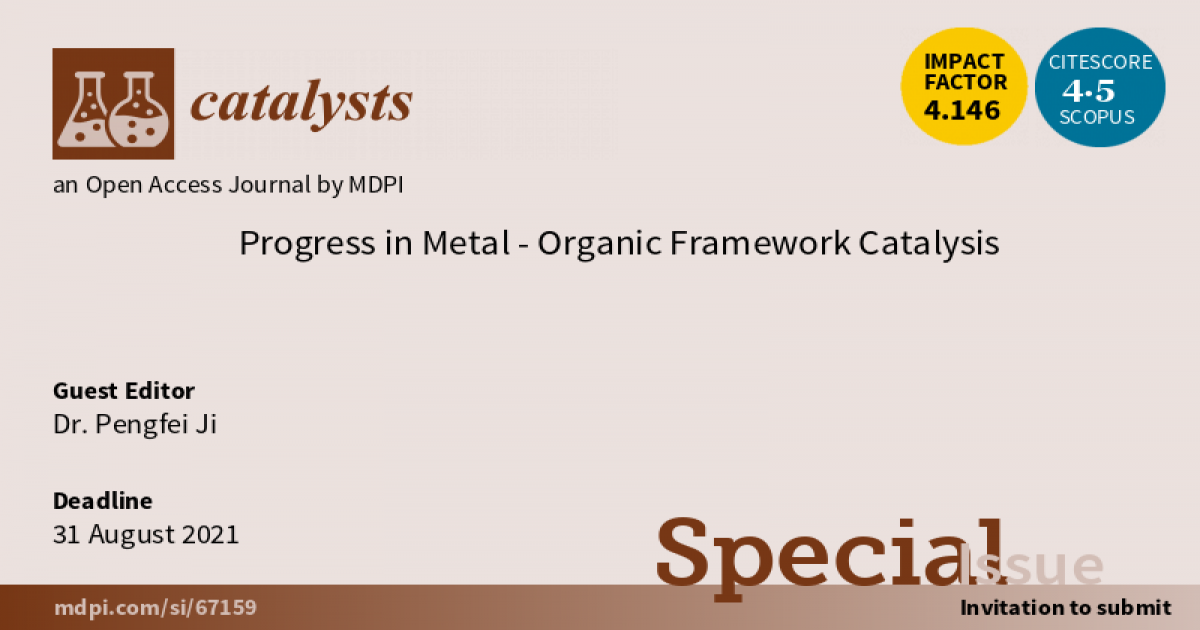- 4.0Impact Factor
- 7.6CiteScore
- 17 daysTime to First Decision
Progress in Metal-Organic Framework Catalysis
This special issue belongs to the section “Catalytic Materials“.
Special Issue Information
Dear Colleagues,
The study of a special class of porous material known as metal-organic frameworks (MOFs) has attracted broad interest over the past two decades. MOFs are constructed from inorganic metal nodes and bridging organic linkers to create single crystalline frameworks with periodic porosity. MOFs share a similarity to industrially important zeolite catalysts that are characterized by large internal surface areas and uniform pore sizes. Even nicer, MOFs can be constructed from a variety of organic linkers and inorganic nodes to afford countless types of single-site solid catalysts.
The structural diversity and synthetic versatility of MOFs allows for the fine-tuning of electronic and steric properties of their catalytic active sites, which is difficult to achieve using classical heterogeneous catalysts. Compared to homogeneous catalysts, the active species of MOFs are site-isolated, which is crucial for avoiding intermolecular decomposition pathways including metal-ligand disproportionation, oligomerization, or ligand transformation processes to form catalytically inactive species. The feature that is attracting more and more attention in recent years is that MOF catalysts contain periodic cavities, which allow for catalysis to occur in confined space. The cavities offer ideal space for achieving cooperative catalysis of multiple functional groups, and could be redesigned to mimics the active site of enzymes.
The structural uniformity of the active sites inside MOFs allows for their structural and spectroscopic characterizations, which helps revealing the catalytic mechanism of MOF-catalyzed reactions and inspires further designing the improved version of MOF catalysts. X-ray diffraction and electron diffraction are essential to understanding the MOF structure with atom-resolution. Spectroscopic methods, including electron paramagnetic resonance (EPR), X-ray spectroscopy (XAS) and X-ray photoelectron spectroscopy (XPS), are crucial for understanding the electronic property of the metal active sites.
Therefore, we are really excited to start this Special Issue to highlight recent progress in the field of MOF catalysis either in the format of research articles or reviews.
Dr. Pengfei Ji
Guest Editor
Manuscript Submission Information
Manuscripts should be submitted online at www.mdpi.com by registering and logging in to this website. Once you are registered, click here to go to the submission form. Manuscripts can be submitted until the deadline. All submissions that pass pre-check are peer-reviewed. Accepted papers will be published continuously in the journal (as soon as accepted) and will be listed together on the special issue website. Research articles, review articles as well as short communications are invited. For planned papers, a title and short abstract (about 250 words) can be sent to the Editorial Office for assessment.
Submitted manuscripts should not have been published previously, nor be under consideration for publication elsewhere (except conference proceedings papers). All manuscripts are thoroughly refereed through a single-blind peer-review process. A guide for authors and other relevant information for submission of manuscripts is available on the Instructions for Authors page. Catalysts is an international peer-reviewed open access monthly journal published by MDPI.
Please visit the Instructions for Authors page before submitting a manuscript. The Article Processing Charge (APC) for publication in this open access journal is 2200 CHF (Swiss Francs). Submitted papers should be well formatted and use good English. Authors may use MDPI's English editing service prior to publication or during author revisions.
Keywords
- Metal-Organic Frameworks
- Catalysis
- enzyme-mimetics
- single-site
- oxidation
- reduction
- polymerization
- acid-base catalysis
- renewable energy

Benefits of Publishing in a Special Issue
- Ease of navigation: Grouping papers by topic helps scholars navigate broad scope journals more efficiently.
- Greater discoverability: Special Issues support the reach and impact of scientific research. Articles in Special Issues are more discoverable and cited more frequently.
- Expansion of research network: Special Issues facilitate connections among authors, fostering scientific collaborations.
- External promotion: Articles in Special Issues are often promoted through the journal's social media, increasing their visibility.
- e-Book format: Special Issues with more than 10 articles can be published as dedicated e-books, ensuring wide and rapid dissemination.

